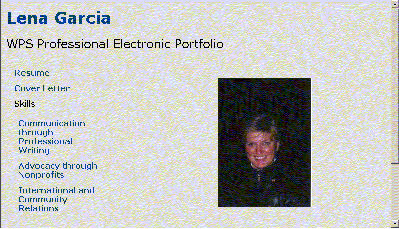Collaboration
In IDS 300W, we discuss the concepts of critical thinking, interdisciplinarity, interdisciplinary teams, and community. In IDS 487 and 497, as we work on e-portfolios, we are putting these concepts into practice. We are a community of learners trying to understand interdisicplinarity through the lens of work and to more clearly define, describe and present our workplace skills and knowledge. Applying aspects of critical thinking is crucial to the reflective process of creating an eportfolio and providing feedback to each other. We found that collaborative efforts foster the construction of effective e-portfolios, increasing our awareness of personal and professional development and assisting us in understanding the range of audiences.
In IDS 497, we discuss a variety of ways in which we can work collaboratively and provide feedback to each other: in-class discussion, Blackboard discussion board, and WPS Eports “share, view and comment.” We use these avenues for initiating ideas, raising questions to clarify portfolio elements, build effective documents and assess what we’ve completed. Asking and responding to questions help us to be active participants, open to other perspectives and to the possibility of changing our own. We define ourselves as a community of learners, using collaboration to contribute to a constructive learning environment, fostering our best work. Students like Lena, below, demonstrate this process.
From Lena to Rachel: When we were in class a couple weeks ago, you talked about your skill in website design. That stuck with me so much -- you made me think, "I could do that, too!" instead of always having to wait on someone else to make web pages for me. I went on the Internet and found that the Princess Anne Rec Center offers regular online courses in web page design. I signed up, and I can't believe that I can type html now! I'm halfway through the 6-week class. So I thank you for getting me going on that. I still encourage you to highlight that among your skills/talents. Even though you consider it a hobby, it is such a vital skill in today's world that you can get hired for it! Good luck.
Self-assessment at the end of one class and the beginning of the next helps students to see their original skills, their emerging skills and knowledge, and the goals they want to set. This process parallels the use of the eportfolio as a lifelong education and career tool.

Figure 2. Lena's WPS Portfolio
index page
Lena: "The portfolio is a way of making a commitment to what you want to do in the future." That is exactly true. It's much bigger than finishing the course and getting the credits needed to graduate. It's figuring out what I want to do with the rest of my life, considering the skills and experience I've gained, what I love to do, and the fact that for the first time in my life I can say that I'm a college graduate. It's very exciting. My three skill areas in 487 were: Communication through Professional Writing, International Relations, and Nonprofits. I want to stick with Writing and Nonprofits. Mary Beth suggested the word Advocacy, which covers my volunteer work. I like Becky’s use of the term Community Relations. And here’s one I didn’t see coming: I’m feeling pulled to work with teens and adolescents and families in need again, which is full-circle from where I started. (See a screenshot of Lena's portfolio in Figure 2.)
At the end of IDS 487, Sara, a mother of five and an aspiring lawyer, writes:
Over the past semester I have had to develop two application packages. I can only describe the entire process as one of portfolio building. Although I did not have to focus on any particular skills, I had to reflect, connect and disseminate my purpose. I think that I am truly ready to dive into my portfolio. As for the skills, I will remain focused on my soft skills, until I excel from the academic arena. I have already experienced the “real world of hard skills, ladder climbing, back braking promotion”. Today, I am faced with the “WHAT NOW.” I borrowed that from Monica. As for my hard skills; Management, Customer Service, Marketing… I see them as being transparent - revealing my true skills: Leadership, and Communication (writing). I can honestly say that without my experience in this class, I would not have been able to create such an awesome admission package for Law school. I am now stepping away from that project, going back to the drawing board (e-ports) and reorganizing my self- portrait.
Susan S. at the beginning of IDS 497, reviews comments from classmates on Blackboard:
Yes, all very good advice! It has generated some new ideas. One thing that I had been thinking about recently was that I really comfortable with the ability to move out of the Healthcare Recruitment field once I get my degree. And, as loyal as I feel toward my old employer (Sentara), I no longer quite feel the homesickness that I used to feel when I first left. This time out of the standard workforce has given me an opportunity to learn more about myself and take my time to seek out what I want to do rather than just dive right back into another recruitment role. I'm not really has stuck or hung up on this one issue as it seems from the discussion threads. I think I've gotten great advice.
Working (on) Electronic Portfolios
Connecting
Academic Work and
the Workplace